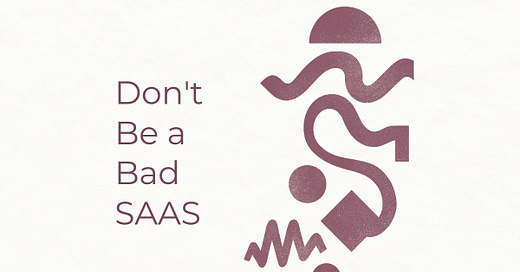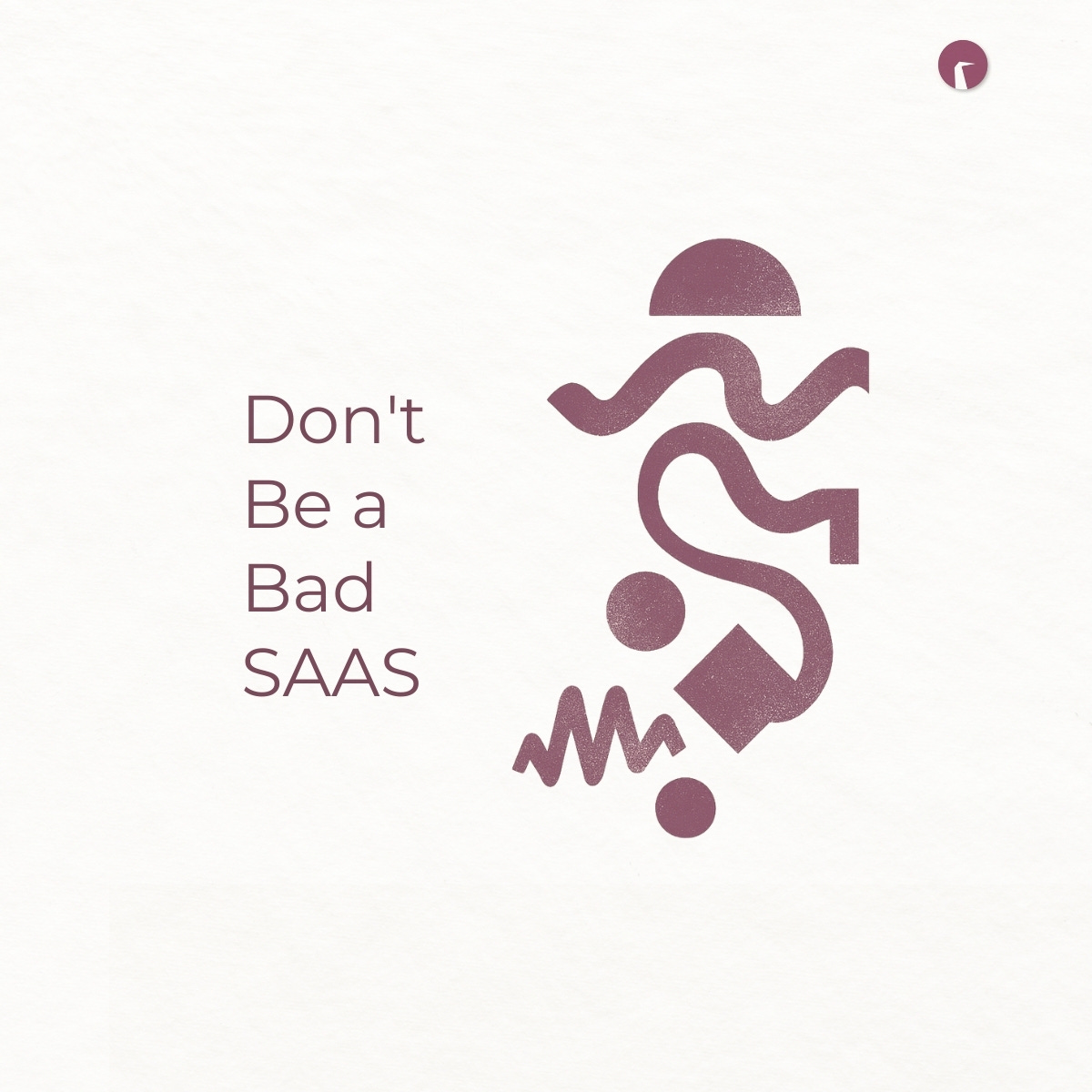✤ Why SaaS feels stagnant
✤ SaaS was supposed to revolutionize business software, replacing clunky on-premise tools with sleek, always-on, cloud-based platforms.
✤ Instead, what we got was an industry obsessed with locking users into rigid ecosystems, charging for bloated feature sets, and forcing companies into endless onboarding cycles.
✤ Most SaaS tools today aren’t truly innovative. They’re just interfaces — overbuilt dashboards that require users to do all the work.
✤ If you’ve ever felt that your CRM, project management tool, or analytics platform is just a prettier version of an Excel spreadsheet, you’re not alone.
✤ The real issue? SaaS isn’t designed to grow with you — it’s designed to keep you locked in.
You don’t choose a tool because it’s perfect; you choose it because switching is painful.
You pay for hundreds of features but actively use maybe five.
You spend more time managing the software than actually getting results from it.
SaaS is no longer about efficiency. It’s about creating habits, not outcomes.
What comes after SaaS?
The next generation of software won’t be defined by interfaces, but by adaptability.
Instead of rigid platforms with static workflows, we’ll see modular, AI-driven systems that configure themselves around the user’s real needs.
✧ Functionality over subscription
✧ Today’s SaaS pricing models force users into fixed tiers — enterprise, pro, starter — where features are bundled arbitrarily.
✧ The future is adaptive, usage-based pricing tied directly to outcomes.

Imagine:
Instead of paying for a marketing suite, you pay per successful campaign generated by AI.
Instead of a fixed fee for a recruiting tool, you pay per high-quality candidate identified.
Instead of a data analytics subscription, you pay for actionable insights — not for staring at dashboards.
The shift: From "owning a tool" to "receiving a result."
✧ AI as a process, not a feature
✧ Right now, AI is bolted onto SaaS products like an afterthought — a chat widget here, an “AI-powered” label there.
✧ But true AI-first software won’t need dashboards, because it won’t need you to tell it what to do.
AI-driven hiring platforms won’t just store resumes — they’ll identify retention risks before an employee even considers leaving.
Financial planning software won’t require manual input — it will anticipate cash flow challenges and adjust strategies in real time.
Customer service AI won’t wait for tickets — it will prevent customer churn before support is even needed.
The shift: From "tools you interact with" to "autonomous systems that act before you do."
✧ Interfaces should disappear — or at least shrink
✧ The best interface is the one you don’t have to think about. Most SaaS products today bombard users with dashboards, reports, and settings.
✧ Modern software should work invisibly in the background, surfacing only what’s important.
Instead of staring at a dashboard, you receive an alert only when something is truly relevant.
Instead of digging through data, you get a decision-ready insight, not a dozen charts to interpret.
Instead of endless settings, the system learns and adjusts itself based on your patterns.
The shift: From "more control" to "less cognitive load."
✧ AI + Human oversight: the hybrid model
✧ Autonomous systems are powerful, but humans will always be essential. The real innovation isn’t full automation — it’s smart augmentation.
AI should handle the first 80% of decision-making, surfacing only complex cases for human review.
AI should highlight anomalies, propose solutions, and refine predictions based on human input — not just blindly execute.
AI should not replace human intuition, but enhance it by handling repetitive, high-volume tasks.
The shift: From "AI replacing humans" to "AI making humans 10x more efficient."
Core features of service as a software
Data-Driven at its core – unlike traditional SaaS, the system doesn’t wait for manual input; it analyzes and makes decisions autonomously.
Deep automation – AI and algorithms minimize manual work, shifting towards self-operating solutions.
API-first approach – services are fully accessible via APIs, eliminating the need for direct interaction with interfaces.
Modular, not monolithic – instead of rigid platforms, adaptive ecosystems allow users to mix and match services as needed.
Flexible monetization – no more paying for access; pricing is based on API calls, processed data, or achieved business outcomes.
What happens to SaaS?
➊
Legacy SaaS players will struggle to adapt
✲ Big platforms thrive on complexity. Their business model relies on companies committing to multi-year contracts.
✲ If software becomes modular and adaptable, these monoliths lose their grip.
✲ Many of them will try to acquire AI-first startups, but their core architecture and pricing models are fundamentally outdated. Retrofitting AI won’t be enough.
➋
AI-first platforms will kill feature-bloated SaaS
✲ The fastest-growing tech companies will not be "products" but infrastructure layers that enable AI-driven automation.
✲ The future isn’t about selling software licenses — it’s about selling access to intelligent workflows.
✲ Who’s leading this shift? OpenAI, Anthropic, Adept AI, and emerging AI infrastructure startups building real-world automation.
➌
Traditional SaaS pricing will collapse
✲ If companies can pay for outcomes instead of subscriptions, why would they keep paying for unused features?
✲ Expect a massive shift from annual contracts to pay-per-use and value-based pricing.
⍜ Bonus: why do people tolerate bad SaaS?
⍜ Cognitive Habit #1: the switching pain fallacy
⍜ Most SaaS survives not because it’s great — but because switching feels like a hassle. This is why:
Companies build deep integrations into broken tools, making migration hard.
Training employees on a new tool feels more expensive than just tolerating inefficiencies.
Businesses fear data loss from switching platforms.
What AI-first platforms do differently: They integrate flexibly, replacing only specific tasks, not entire platforms.
⍜ Cognitive habit #2: the “More Features = More Value” illusion
⍜ Users equate feature-rich with powerful, but:
80% of users only use 10-20% of features in any given SaaS tool.
Overwhelming UIs make people think they’re productive when they’re just managing software.
What AI-first platforms do differently: They surface only what matters, reducing user workload.
✢ Who’s leading vs. who’s falling behind?
✢ Already leading this shift:
→ AI models becoming infrastructure, not just tools.
→ Building AI that can use software like a human assistant.
→ Automating decision-making, not just providing dashboards.
→ Low-code automation replacing custom SaaS for many workflows.
✢ Stuck old SaaS thinking:
→ Still rely on massive sales teams selling bloated, multi-year contracts.
→ Selling interface-heavy platforms instead of intelligence.
→ SaaS tools that just add AI labels but don’t rethink workflows.
Software should adapt to users, not the other way around.
The tools of the future won’t be just better interfaces — they’ll be invisible, proactive, and focused on delivering real, tangible outcomes.
The companies that embrace this shift — those that build for efficiency, adaptability, and direct value creation — will define the next decade of software.
The ones that don’t? They’ll be just another subscription we all forget to cancel.
What do you think? Is AI-first automation inevitable? Or will SaaS somehow survive?







The tools of the future won’t be just better interfaces — they’ll be invisible, proactive, and focused on delivering real, tangible outcomes.